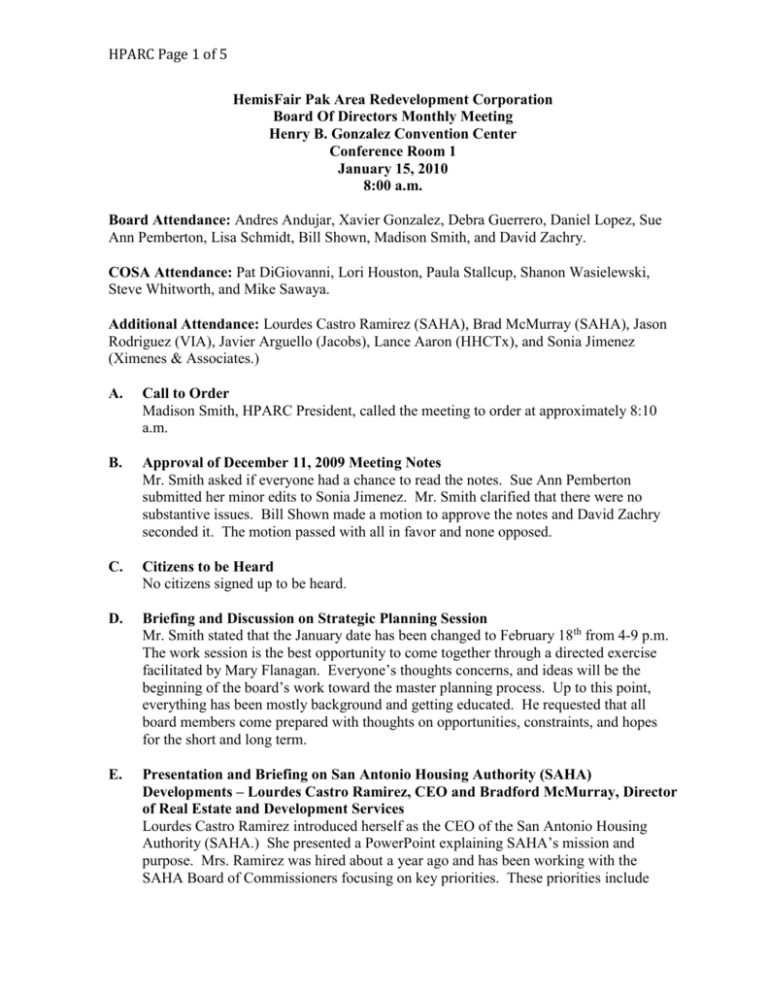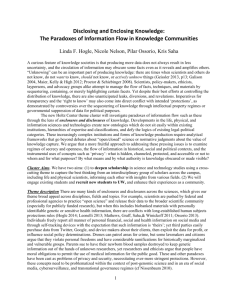HemisFair Pak Area Redevelopment Corporation
advertisement

HPARC Page 1 of 5 HemisFair Pak Area Redevelopment Corporation Board Of Directors Monthly Meeting Henry B. Gonzalez Convention Center Conference Room 1 January 15, 2010 8:00 a.m. Board Attendance: Andres Andujar, Xavier Gonzalez, Debra Guerrero, Daniel Lopez, Sue Ann Pemberton, Lisa Schmidt, Bill Shown, Madison Smith, and David Zachry. COSA Attendance: Pat DiGiovanni, Lori Houston, Paula Stallcup, Shanon Wasielewski, Steve Whitworth, and Mike Sawaya. Additional Attendance: Lourdes Castro Ramirez (SAHA), Brad McMurray (SAHA), Jason Rodriguez (VIA), Javier Arguello (Jacobs), Lance Aaron (HHCTx), and Sonia Jimenez (Ximenes & Associates.) A. Call to Order Madison Smith, HPARC President, called the meeting to order at approximately 8:10 a.m. B. Approval of December 11, 2009 Meeting Notes Mr. Smith asked if everyone had a chance to read the notes. Sue Ann Pemberton submitted her minor edits to Sonia Jimenez. Mr. Smith clarified that there were no substantive issues. Bill Shown made a motion to approve the notes and David Zachry seconded it. The motion passed with all in favor and none opposed. C. Citizens to be Heard No citizens signed up to be heard. D. Briefing and Discussion on Strategic Planning Session Mr. Smith stated that the January date has been changed to February 18th from 4-9 p.m. The work session is the best opportunity to come together through a directed exercise facilitated by Mary Flanagan. Everyone’s thoughts concerns, and ideas will be the beginning of the board’s work toward the master planning process. Up to this point, everything has been mostly background and getting educated. He requested that all board members come prepared with thoughts on opportunities, constraints, and hopes for the short and long term. E. Presentation and Briefing on San Antonio Housing Authority (SAHA) Developments – Lourdes Castro Ramirez, CEO and Bradford McMurray, Director of Real Estate and Development Services Lourdes Castro Ramirez introduced herself as the CEO of the San Antonio Housing Authority (SAHA.) She presented a PowerPoint explaining SAHA’s mission and purpose. Mrs. Ramirez was hired about a year ago and has been working with the SAHA Board of Commissioners focusing on key priorities. These priorities include HPARC Page 2 of 5 improving the quality of life for their residents, preserving and expanding affordable housing, strengthening basic services and systems, and partnering with developers. SAHA’s main planning objective is to create new communities with mixed-income properties. SAHA is engaged in collaborative planning with the COSA, VIA, and the school districts for their development efforts. Federal level funding is being received from HUD, Department of Education, and the Department of Transportation. Funding from these various sources allows for a more comprehensive approach to planning. SAHA needs to create housing units for clients earning less than 30% of median income. They have a $68M budget with 6,300 non-profit and affordable housing units and 6,300 subsidized through the Section 8 voucher program. The mayor appoints the SAHA Board of Commissioners. Ramiro Cavazos is the current chairman and Brian Hermann is their vice-chairman. Mrs. Ramirez then turned the presentation over to Brad McMurray, SAHA’s Director of Real Estate and Development Services. Mr. McMurray continued the presentation. He gave the board information related to the history of the former Victoria Courts, which are now the Victoria Commons and Artisan’s Village. The newest development, HemisView, is expected to be complete in June of this year. SAHA has received federal Hope VI grants and are looking into Build America bonds. SAHA also received federal funds to do improvements to Labor and Leigh Streets. HemisView is designed in a Texas Wrap design with residential units on the perimeter of the development and the parking garage in the middle. The development will have 1.5 parking spaces per unit. The design allows for more density on the downtown side of the property with a four-story complex and becomes less dense towards the residential side of the property with single-family dwellings on the Leigh Street side. This decision was based on community input and it allows for the property to blend in nicely with the existing neighborhood. Mr. McMurray also distributed maps showing other SAHA properties and future developments in the downtown area. He concluded his presentation and asked for questions. The complete build-out of the redeveloped Victoria Courts will have 600 units serving approximately 2,000-2,500 consumers. Victoria Courts had 660 units and those residents were provided Section 8 vouchers when Victoria Courts was demolished. The former residents are given priority (no waiting list) to move back and many have moved back into Refugio Place. However, many former residents are now Section 8 clients instead of non-profit public housing clients. Section 8 residents are much harder to track and this creates problems with delivery of services. SAHA is in the process of exploring ways to reach Section 8 residents through education initiatives and collaborating with other service providers. The overall percentage of the mix between affordable and market rate housing is about 25% market with the addition of HemisView, 20% public housing, and 55% affordable housing. Affordable housing is considered 80% of median but 60% for tax purposes. SAHA does track income levels to include their market rate products. Currently, many students who live at Refugio Place are students earning 120% of median income and HemisView may change this figure. HemisView is an opportunity to have an “A+” HPARC Page 3 of 5 property in a great location that can attract residents earning above the 120% mark. SAHA’s design review process includes a public review component and they are in the process of expanding the review process. The process used for the HemisView project included participation from the LaVaca neighborhood. Many of the HemisView design changes are a result of community input. The design review process also included State Historic Preservation Office (SHPO) review and approval because of HemisView’s proximity to the LaVaca neighborhood. SAHA also worked with the San Antonio Conservation Society to get input on their desire for the Administration Building redevelopment located in the same area. SAHA would like a process that allows for more upfront planning. However, upfront planning requires an upfront investment that may not be available. Funding grants and other revenue sources are very competitive and SAHA is trying to collaborate to pool these available resources. Mr. Smith thanked Mrs. Ramirez and Mr. McMurray for the presentation and information. He requested that SAHA keep the board apprised of any new developments with their projects and appreciated this opportunity to learn more about the agency. F. Presentation and Briefing on VIA Metropolitan Transit Streetcar Study – Jason Rodriguez, VIA Planning Department and Javier Arguello, Jacobs Transportation Planning Jason Rodriguez with VIA introduced himself and began his presentation by stating that the Streetcar Study is still in the process phase and the study is not yet finalized. VIA began the streetcar feasibility and long-range study in May 2009. Phase 1 was completed in February and the long-range portion should be completed this summer. VIA is currently in the process of wrapping up the needs assessment and identifying corridors and a multi-modal approach to planning is being utilized. Monorail and heavy rail have been eliminated as transit options. The streetcar system will utilize a fixed guide way system with overhead electrical connections. The Downtown Alliance brought the streetcar concept to VIA and are partners with them on this project. Mr. Rodriguez turned the presentation over to Javier Arguello with Jacobs Transportation Planning consulting firm. Mr. Arguello explained that the process includes a technical advisory committee (TAC) made up of various agency representatives. The TAC has developed a draft report with preliminary findings and alignments. The report has been presented to the inner city rail commission for consideration. The report includes a Peer City Study Summary. This study indicates that shorter starter alignments allow for quick implementation and that ridership forecasts generally are lower than actual ridership once the system is operational. All major cities along IH-35 are getting streetcar systems – Waco, Austin, Dallas, and Oklahoma City. VIA is also utilizing the concept of transit-oriented development to help spur economic development and the desired density for the downtown area. Mr. Arguello stressed the importance of land use and coordination with all the stakeholders for a successful program. The evaluation criteria for the starter line includes equity, cost effectiveness, and the best opportunities for private and public HPARC Page 4 of 5 investment. The starter alignment being proposed is the NS1A alignment presented in the handouts. The presentation was concluded and the discussion was opened up to questions. The proposed starter system will run north and south on Alamo Street just west of HemisFair. There are two alternatives that run east and west, which may be implemented at a later time. These alternatives would run down Nueva Street, through HemisFair, to the Robert Thompson Transit Station. The long-term plan includes closing this loop. The east-west proposed alignments would generally run from Our Lady of the Lake on the west to the AT&T Center on the east. The starter east-west line will only go to the Westside multi-modal station located on the near Westside. The best case scenario for having the first line fully operational is by the year 2014. This scenario presumes a $25M federal funding grant is awarded. The total cost for the starter system is $80M. In terms of other cities funding rail project from increased tax revenues collected as a result of economic development, it seems every city with a successful system has had a different experience. Portland’s system was implemented with public sector money and its expansion and success is based on mostly private investment. Seattle’s system relied much more heavily on private sector funds. Public sector financing generally is available in the form of public improvement districts (PIDs) – private sector developers and property owners petition to tax themselves to form a PID. All projects evaluated in the peer city study have a mix of funding revenues. Portland added a 25¢ fee to parking fees and had a total of 22 funding sources. The planners are looking at a shorter version of the originally proposed east-west starter alignment of 7.2 miles with a cost of $390M. There is no firm date for the east-west alignment but the goal would be to begin the process as soon as the starter line (north-south) is implemented. Mr. Smith thanked the gentlemen for their time and information. He looks forward to working with VIA as the plan comes to fruition. G. Briefing and possible action regarding the relocation of the San Antonio Park Police from the Richter House to the Espinoza House - Paula X. Stallcup, Downtown Operations Director. Paula Stallcup informed the board that the San Antonio Park Police are interested in relocating from their current offices located in HemisFair at the Richter House to the Espinoza House at HemisFair. The Espinoza House is located next door to the San Antonio Parks Foundation. If this committee approves of the relocation, then aesthetic improvements (paint and flooring) to the Espinoza House will begin as early as next week. The Park Police are agreeable to a month-to-month lease arrangement with the knowledge that they have to relocate again at some point. The board was reminded that the finance committee is currently looking at all the leases and a presentation to the full board is expected in a couple of months. With the exception of the Amaya Deli, all other current tenants in the park are non-profits. HPARC Page 5 of 5 Debra Guerrero made a motion to approve the Park Police relocation and Andres Andujar seconded it. The motion passed with all in favor and none opposed. Daniel Lopez stressed the importance of the process of vetting leases through the finance committee. Even though this particular lease was not put through the process, the process will be instituted within the next couple of months and board members are encouraged to attend every meeting to ensure their participation in it. Michael Sawaya inquired about the UNAM lease. The board approval was postponed from last month. The finance committee will review the lease terms this week and the board may take action prior to the February planning session. The item was referred back to the finance committee for further review since UNAM is not a City department. Mr. Smith stated that real estate issues might be discussed in executive session, as opposed to in an open meeting, in the future depending on the complexity and the nature of the issue. H. Director's Report – Pat DiGiovanni, Deputy City Manager Pat DiGiovanni reported that the City is inching closer to a final agreement with the federal GSA for the land swap. Both parties are working through the environmental language and doing their due diligence. The next board meeting may include an executive session to discuss a potential scenario regarding activity outside of the park that could benefit the park as well as the surrounding area. This week the city council will consider bridging documents for the SAPD headquarters and the process for beginning construction at the former Kmart property. Mr. DiGiovanni also informed the board that at the January 21st city council session, the resolution to support the center city partnership will be considered. The Centro partnership information was presented to this board at a previous meeting. I. Other Items Sue Ann Pemberton added that her students’ work on the conditions assessment is mostly complete. She is working with Mrs. Stallcup to determine what City staff can do to remediate some of the issues. Ms. Pemberton will present her findings to the board once the final report is complete sometime this spring. J. Adjournment Mr. Smith asked if there was any other business and there was no reply. He adjourned the meeting at approximately 12:10 p.m.









